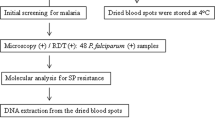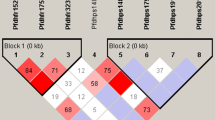Abstract
The rapid spread of antimalarial drug resistance in Plasmodium falciparum over the past few decades has necessitated intensive monitoring of such resistance for an effective malaria control strategy. P. falciparum dihydropteroate synthase (Pfdhps) and P. falciparum dihydrofolate reductase (Pfdhfr) genes act as molecular markers for resistance against the antimalarial drugs sulphadoxine and pyrimethamine, respectively. Resistance to pyrimethamine which is used as a partner drug in artemisinin combination therapy (ACT) is associated with several mutations in the Pfdhfr gene, namely A16V, N51I, C59R, S108N/T and I164L. Therefore, routine monitoring of Pfdhfr-drug-resistant alleles in a population may help in effective drug resistance management. Allele-specific PCR (ASPCR) is one of the commonly used methods for molecular genotyping of these alleles. In this study, we genotyped 55 samples of P. falciparum for allele discrimination at four codons of Pfdhfr (N51, C59, S108 and I164) by ASPCR using published methods and by Sanger’s DNA sequencing method. We found that the ASPCR identified a significantly higher number of mutant alleles as compared to the DNA sequencing method. Such discrepancies arise due to the non-specificity of some of the allele-specific primer sets and due to the lack of sensitivity of Sanger’s DNA sequencing method to detect minor alleles present in multiple clone infections. This study reveals the need of a highly specific and sensitive method for genotyping and detecting minor drug-resistant alleles present in multiple clonal infections.


Similar content being viewed by others
References
Ahmed A, Bararia D, Vinayak S, Yameen M, Biswas S, Dev V, Kumar A, Sharma YD (2004) Plasmodium falciparum isolates in India exhibit a progressive increase in mutations associated with sulphadoxine-pyrimethamine resistance. Antimicrob Agents Chemother 48:879–889
Ahmed A, Das MK, Dev V, Saifi MA, Sharma YD (2006) Quadruple mutations in dihydrofolate reductase of Plasmodium falciparum isolates from Car Nicobar Island, India. Antimicrob Agents Chemother 50:1546–1549
Das S, Barkakaty BN, Roy JR, Guha AK, Rastogi AC (1981) Pyrimethamine in combination with sulfadoxine or sulfalene in P. falciparum infected cases in India. Indian J Malariol 18:109–116
Dash AP, Valecha N, Anvikar AR, Kumar A (2008) Malaria in India: challenges and opportunities. J Biosci 33:583–592
Lin JT, Juliano JJ, Wongsrichanalai C (2010) Drug-resistant malaria: the era of ACT. Curr Infect Dis Rep 12:165–173
Lozovsky ER, Chookajorn T, Brown KM, Imwong M, Shaw PJ, Neafsey DE, Weinreich DM, Hartl DL (2009) Stepwise acquisition of pyrimethamine resistance in the malaria parasite. Proc Natl Acad Sci U S A 106:12025–12030
National drug policy for malaria (2010) NVBDCP, MoH & FW, Govt. of India 2010
National Institute of Malaria Research. Guidelines for the diagnosis and treatment of malaria in India (2009) http://www.mrcindia.org/Guidelines_for_Diagnosis_and Treatment.PDF
Newton CR, Graham A, Heptinstall LE, Powell SJ, Summers C, Kalshekerl N, Smith JC, Markham AF (1989) Analysis of any point mutation in DNA. The amplification refractory mutation system (ARMS). Nucleic Acids Res 17:2503–2516
Peterson DS, Walliker D, Wellems TE (1988) Evidence that a point mutation in dihydrofolate reductase-thymidylate synthase confers resistance to pyrimethamine in falciparum malaria. Proc Natl Acad Sci U S A 85:9114–9118
Sehgal PN, Sharma MID, Sharma SL, Gogai S (1975) Resistance to chloroquine in falciparum malaria in Assam state, India. J Commun Dis 5:175–180
Shah NK, Dhillon GP, Dash AP, Arora U, Meshnick SR, Valecha N (2011) Antimalarial drug resistance of Plasmodium falciparum in India: changes over time and space. Lancet Infect Dis 11:57–64
Sharma YD (2012) Molecular surveillance of drug-resistant malaria in India. Curr Sci 102:696–703
Singh JJSB (1956) Stain—a review. Indian J Malariol 10:117–129
Singh B, Bobogare A, Cox-Singh J, Snounou G, Abdullah MS, Rahman HA (1998) A genus and species-specific nested polymerase chain reaction malaria detection assay for epidemiologic studies. Am J Trop Med Hyg 60:687–692
WHO (2013) World malaria report 2013. World Health Organization, Geneva
Acknowledgments
DS and ML acknowledge the award of Senior Research Fellowship by University Grants Commission, Government of India. The work was supported by intramural grant of the National Institute of Malaria Research (NIMR/VBC/2010/162). CLD was supported by National Institute of Allergy and Infectious Diseases, National Institutes of Health (NIH) grant U19AI089676. The content is solely the responsibility of the authors and does not necessarily represent the official views of the National Institutes of Health or National Institute of Malaria Research.
Compliance with ethical standards
ᅟ
Ethics approval
The study has been approved by the Institutional Ethics Committee (IEC) of National Institute of Malaria Research with approval number ECR/NIMR/EC/2012/42.
Author information
Authors and Affiliations
Corresponding author
Rights and permissions
About this article
Cite this article
Sharma, D., Lather, M., Dykes, C.L. et al. Disagreement in genotyping results of drug resistance alleles of the Plasmodium falciparum dihydrofolate reductase (Pfdhfr) gene by allele-specific PCR (ASPCR) assays and Sanger sequencing. Parasitol Res 115, 323–328 (2016). https://doi.org/10.1007/s00436-015-4750-2
Received:
Accepted:
Published:
Issue Date:
DOI: https://doi.org/10.1007/s00436-015-4750-2




